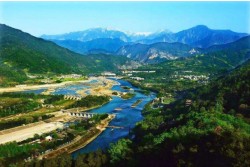

Introducing Mount Qingcheng (UNESCO says of Mount Qingcheng)
Mount Qingcheng, dominating the Chengdu plains to the south of the Dujiangyan Irrigation System, is a mountain famous in Chinese history as the place where in 142 CE the philosopher Zhang Ling founded the doctrine of Chinese Taoism. Most of the essential elements of Taoism culture are embodied in the teachings of Taoism that emanated from the temples that were subsequently built on the mountain during the Jin and Tang dynasties. The mountain resumed its role as the intellectual and spiritual centre of Taoism in the 17th century. The eleven important Taoist temples on the mountain reflect the traditional architecture of western Sichuan and include the Erwang Temple, the Fulong Temple, the Changdao Temple built over the place where Zhang Ling preached his doctrines, and the Jianfu Palace (formerly the Zhangren Temple).
Mount Qingcheng Fast Facts
• Chinese Name: Qing Cheng Shan 青城山
• Best Time to Visit: April to October
• Recommended Visiting Hours: About 3 to 4 days
• Things to Do: Photography, Hiking, Taoism
• Opening Hours: 08:00-18:00 from Dec to Mar 1; 08:00-17:00 from Mar 02 to Nov
• Entrance Fee: CNY 80 for front mountain; CNY 20 for rear mountain
• Address: Mount Qingcheng Scenic Area, Southwest of Dujiangyan, Sichuan Province
What to expect at Mount Qingcheng
Mount Qingcheng has unique geology and landform, lush vegetation, favorable climate, green trees, steep mountains, winding paths, and interesting temples. There are 36 peaks, 72 caves and 108 scenic spots. As early as in the end of third century BC, Mount Qingcheng was conferred as one of 18 well-known mountains and rivers for national sacrificial rites of the Qin Dynasty. It is rich in charming natural scenery, such as gushing sunrise of the First Peak of Mount Qingcheng, sunset glow of Chaoyang Cave, vast sea of clouds of Zhangren Peak, steep Ladder to Heaven, wonderful Yuanyang Spring, plunging waterfall of Hongyan Valley and clear Weijiang River. In 143 AD, Celestial Master Zhang Daoling, Founder of Tianshi Tao (Way of the Celestial Masters), came to Mount Qingcheng and found the "Wudoumi Tao" (Way of Five Bushels of Rice) based on the Theory of Huangdi and Lao Tzu, namely the Tianshi Tao. Mount Qingcheng is the birthplace of Chinese Taoism as well as ancestral mountain and court of Tianshi Tao.
To get around Mount Qingcheng doesn't require any specific route or plans. The grasses and forests delight endlessly, so fancy should be the guide. To overcome fatigue, stop for a cup of tea in one of the tranquil gardens. To curb hunger, take a break for a delicious vegetarian meal.
No trip to Sichuan would be complete without a culinary experience, and in this areas the four highly recommended specialties are: Chicken with ginkgo, Qingcheng Kuding tea, Taoist pickles, and Dongtian Milk Spirit. Other delectable offerings include: shipa fish, konjak (a potato-like vegetable) with roast chicken, and Mount Qingcheng preserved meat.
How to get to Mount Qingcheng
• Mount Qingcheng is approximately 70km from downtown Chengdu.
• Take a bus from Chegndu Xinnanmen Bus Station to Qingchengshan.
• Rent a car/bus from GGC to enjoy a hassle free private transfer from hotels in Chengdu to DMount Qingcheng.
Additional travel advice on Mount Qingcheng
• Please wear comfortable hiking shoes and clothes.
• It often rains on the mountain. Please prepare an umbrella or a raincoat along with you.
• Long-sleeved clothes are necessary to prevent mosquito bites or prepare mosquito repellent.
• The roads in the scenic area are complex, please follow the official signs and guidelines and take care of yourselves.